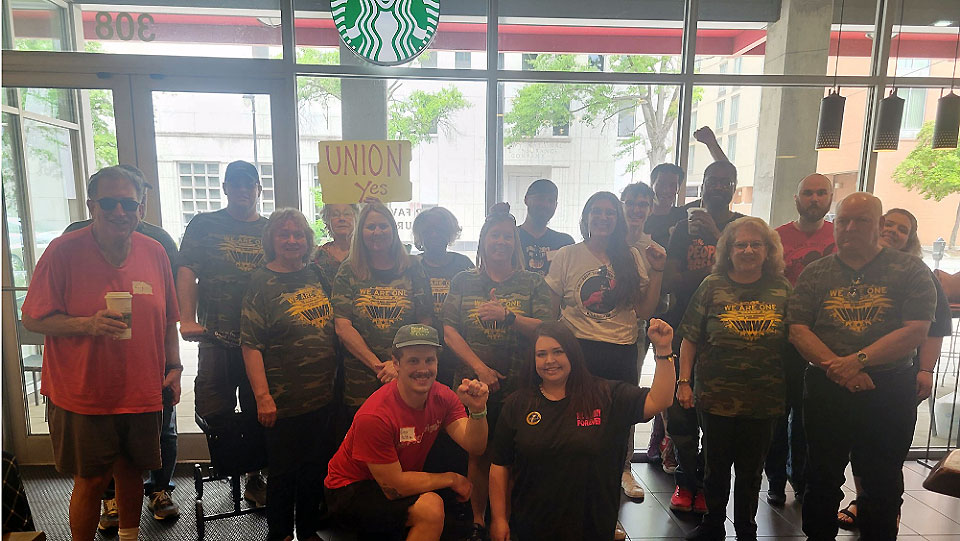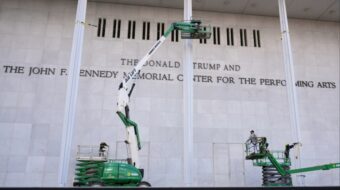
“I’m not anti-union, but the history of unions is based on the fact that companies in the ’40s, ’50s and ’60s abused their people. We’re not in a coal mining business; we’re not abusing our people.” – Howard Schultz, Starbucks CEO
Whether it be the Starbucks baristas in New York or the Warrior Met Coal Miners in Alabama, workers joining together is a dangerous thing for big business. With the organized labor movement being revived in recent years across the economy, it is no wonder corporations are scrambling to put an end to unions, worker coalitions, and a growing collective class consciousness.
Employees at Starbucks have been demanding better working conditions all across the country. In Queens, N.Y., supporters rallied together in July of this year following the illegal firing of Starbucks Workers United (SBU) leader Austin Locke. The dismissal came after he and other workers at the Ditmars Boulevard location successfully won their union election only a week prior. Locke, a barista at Starbucks for over five years, is the first union leader to be fired in New York City.
At the July rally, standing alongside the workers of SBU were members of the Amazon Labor Union, the United Parcel Service Union, the Democratic Socialists of America (DSA), the Young Communist League (YCL), and other organizations. State Assembly member Zohran Mamdani, city council member Tiffany Caban, and State Sen. Mike Gianaris also showed their support. This coalition showed up against union busting and intimidation and stand as a local example of how powerful solidarity can be.
History teaches that divisions among the working class only serve the bosses and that revolutionary power is built through a broad and united front formed by workers of all kinds. With the growing trend of far-right extremism, we must be wary of divisive tactics that pit workers against each other.
There are many examples of particular fields of labor being undervalued and excluded from workplace protections throughout history. One of the ways this happens is through the capitalist myth of “unskilled labor.” The concept has been used to justify poorer treatment, lower wages, and more intense exploitation of certain workers—often people of color and other marginalized groups.
In 1917, the United States Census Bureau expanded its occupational classification system, dividing work fields and qualifications into six groupings. The “unskilled labor” group, which most workers of the time fell under, was defined as a job which “requires no special training, judgment, or manual dexterity, but supplies mainly muscular strength for the performance of coarse, heavy work.” Unsurprisingly, these distinctions were not made in relation to actual technical skill or difficulty, but in occupational relation to property, credit, and business.
This might explain why professions like banking or accounting have historically been valued over manual labor or service work. Today, the Social Security Administration defines unskilled labor as “work which needs little or no judgment to do simple duties that can be learned on the job in a short period of time.”
These jobs, which can be learned quickly and the people who do them can be replaced just as quickly, are where some of the most vulnerable and exploited workers are to be found.
The contradictions of the notion of “unskilled labor” were reflected in the treatment of “essential workers” during the height of the COVID-19 pandemic, when some people were expected to risk their life for minimum wage, while lacking health care and personal protective equipment.
Structurally, these distinctions have made it easier to exclude masses of workers from labor law protections. For instance, agricultural and domestic workers are excluded from the National Labor Relations Act of 1935 (NLRA). This is a policy that “provides employees at private-sector workplaces the fundamental right to seek better working conditions and designation of representation without fear of retaliation.”
In addition, temporary and seasonal workers, because of their “entry-level” status, face pay inequalities for doing the same work as long-term employees, and lose health care benefits when the season ends.
Wildland firefighters, for instance, who are hired seasonally, make $15 to $20 per hour on average. Base pay for rookie fighters, who are required to be physically fit and skillfully prepared upon entry, averages even lower, with some firefighters making just $11 per hour.
California Rep. Tom McClintock faced backlash in July when he did not support more funding for the state’s firefighters. He told The Union Democrat that “wildfire fighting is hot, miserable work, but it is not skilled labor.”
With most of California’s wildfires being fought by prisoners who are being paid pennies (some making as little as under $3 a day), the incentive to keep wages low in the industry becomes clear. The “logic” of unskilled labor is used to justify cost-cutting and exploitative practices.
Culturally, entry level work is also associated with being “uneducated,” allowing an elitism that emphasizes differences to keep lower-income workers stuck while keeping slightly better-paid workers in line.
When commenting on his staff of college-educated writers forming a union, Politico publisher Robert Allbritton stated, “If you’re working in a warehouse, it makes sense. But when you’re talking about smart folks who are using their minds for a very creative project, I don’t get it.”
Making such statements is normal for bosses like Allbritton, who try to convince workers that unions aren’t suited for them. New York Times CEO Meredith Levien was caught sending similar messages to her staff, stating that she wasn’t anti-union, just that the relationship between management and workers would be disrupted and make it harder to work.
At Starbucks, managers use the same reasoning to discourage workers from joining unions. One transgender worker in Oklahoma reported that her manager told her that the company wasn’t against unions, but that joining one may cause workers to lose their gender-affirming health care. Thinly-veiled statements of concern made by management are transparently threatening and intimidating for workers who are going into union elections, regardless of the type of work they perform.
These unnecessary distinctions have warped what it means to be a worker and created long-lasting divides relying on inaccurate comparisons. To those who think retail or restaurant work isn’t difficult, it may seem that the “snowflakes” at Starbucks have it easy. But 47% of them suffer repetitive stress injuries that require physical therapy or surgery, and 62% report mental stress and depression.
These same kinds of distinctions justify underpaying warehouse workers. “How hard can packing boxes be?” it is asked. But in 2021, workers at Amazon reported over 38,000 injuries, a majority being serious enough that they were unable to perform job functions. Amazon workers in Albany, N.Y., have spoken out about employees suffering strokes, heat exhaustion, as well as bodily and head injuries caused by overstuffed shelves and falling packages.

Even though workers at Amazon have differing conditions from those at Starbucks, the struggle for rights and protections is the same. It’s easy for business owners to exploit workers when their labor is undervalued and underappreciated.
To foster the divisions between what was once considered the traditional industrial working class and the new generations of workers making coffee and packing boxes, the right-wing uses all these tactics.
Take the coal miner. The image of the hardworking miner has been used not only by conservative politicians who want to superficially show their support blue-collar workers to gain votes, but also by some misguided leftists who romanticize the brutal exploitation of coal mining and other hard labor, contrasting it to the supposedly softer work of today’s economy.
This false contrast is ironic, considering miners have historically struggled for rights as unskilled laborers themselves. The domination of heavy industry in the U.S. throughout the 20th century put mineworkers and other unskilled laborers at the forefront of the labor movement, making them a target for corporate intimidation.
In 1977, miner Dave Forms, during the height of nationwide coal strikes, spoke on how the fight for unions isn’t an individual battle, but rather something that affects workers everywhere.
“It’s my feeling that right now the operators are making an all out attempt to break the strength of the United Mine Workers. And if they can break the strength of the United Mine Workers, they’re going to break the strength of every other union in this country,” Forms explained.
That 1970s sentiment is still relevant. Union organizing, solidarity, and collective action are still necessary tools for the labor movement.
It should not be contentious to say that all people, no matter where they work, deserve proper pay, safe working conditions, and human decency. The growing workers’ movements at Starbucks, Amazon, and other companies showcase the strength and power of the working class, despite efforts to smash its growth through intimidation and union-busting.
Through solidarity and collective action, we can work to change the exploitative structures and culture around us, getting rid of divisive stratifications and making way for a united working class.
As with all op-eds published by People’s World, this article reflects the opinions of its author.










